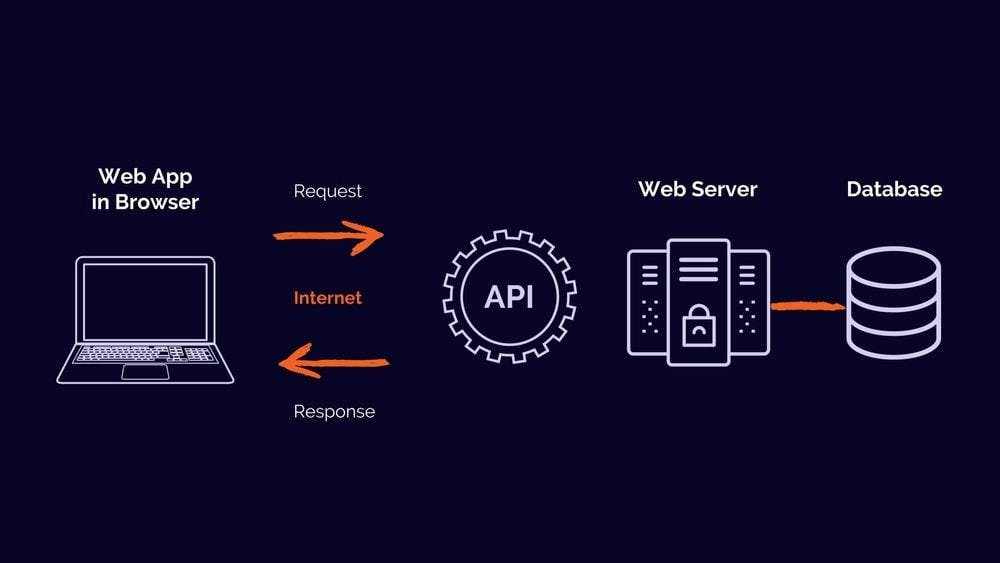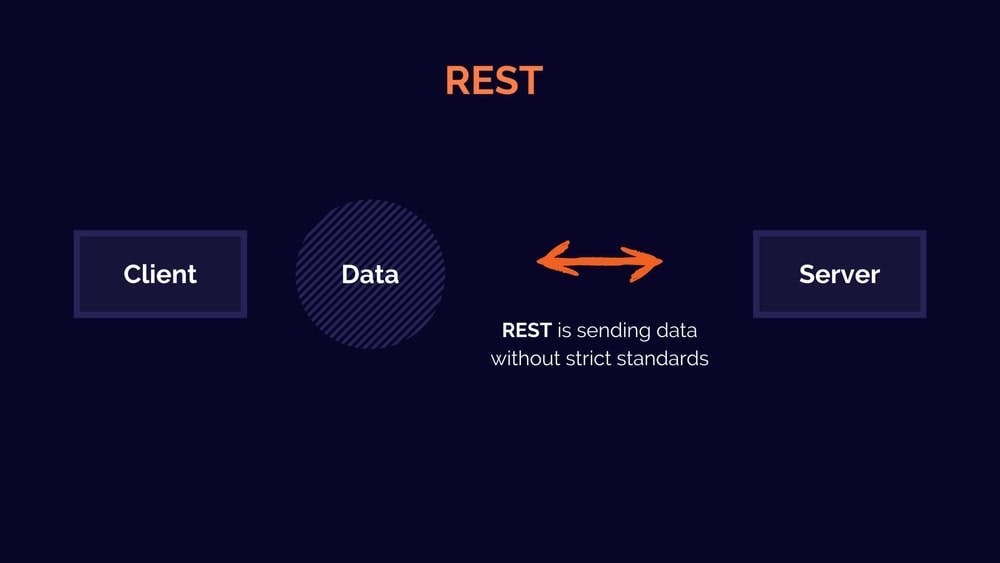REST APIs vs. SOAP APIs: Which One to Choose?
Gabriel Cioci on May 19 2021

It’s popular to compare SOAP vs. REST, two of the most common API paradigms, when discussing API architectures. While the two are often compared as if they were the same, they are certainly not. Why? Because these two are fundamentally different technologies that are difficult to compare on a granular level.
SOAP is a protocol, and REST is an architectural style. They’re packaged differently, have different features, and are used in different situations.
Now that we’ve cleared that up, let’s take a closer look at each — including some of the benefits that could persuade you to choose one over the other for your application.

An API (application programming interface) is an agreement between web services that specifies how they will share data, such as retrieving a map or your login credentials.
The data itself is organized in messages that systems can send to one another.
Types of API

Open APIs, also known as public APIs, have no limits on who can use them since they are public.
Partner APIs require developers to have specific privileges or licenses to use this type of API since they are not accessible to the general public.
Internal APIs, also known as private APIs, are created for internal use within an organization. The company’s internal teams use this form of API to develop its goods and services.
Composite APIs are handy in microservice architectures, where a user can need data from multiple services in order to complete a single task. Since a single call can return all of the data a user requires, composite APIs can minimize server load and increase application performance.
API use cases
APIs are everywhere, powering our lives from behind the scenes, even though we don’t realize it. We’ve compiled a list of five of the most relatable examples of API use in our daily lives to help you better understand what APIs are and how they work.
You’ve probably seen these API integrations everywhere, from logging in with Facebook to paying with PayPal.
1. Log-in using XYZ
One typical API usage example is the “log-in using Facebook/Twitter/Google” functionality found on many websites. It’s advantageous, but have you ever considered how it works?
Instead of explicitly logging into users’ social media accounts (which would be a significant security risk), these websites use these platforms’ APIs to authenticate the user with each login.
2. Weather Snippets
Weather data is another popular API use case that we see every day.
Rich weather snippets seem to be everywhere, found on all platforms, like Google Search, Apple’s Weather app, or even from your smart home device.
Since Google isn’t in the weather data business, they have to rely on a third-party API to provide these details.
3. Travel Booking
Have you ever wondered how travel booking sites are able to aggregate thousands of flights and destinations to find the best deal? Using third-party APIs to gather flight and hotel availability from providers is often the solution.
Similarly, if you book a trip through one of these providers, APIs will be used to validate the trip with the provider from which it was sourced. APIs are beneficial to travel services because they enable machines to share data and requests easily and autonomously.
4. Twitter Bots
The wide range of bots available on Twitter is another example of APIs in action.
Twitter bots are accounts that, based on software instructions, automatically tweet (or retweet), follow, and send direct messages. The Twitter API can also notify bots when anything specific occurs on the site, in addition to allowing you to perform basic actions like Tweeting a particular phrase or following a user.
5. Pay with Paypal
Have you ever used PayPal to make a purchase from an online store?
That is, indeed, an API at work. The “Pay with PayPal” feature is designed with APIs to ensure that the end application can only do what it needs without being exposed to sensitive data or gaining access to unintended permissions.
REST API
REST API, also known as a RESTful web service, is based on representational state transfer, a communication architecture style and approach frequently used in web services development. It uses JSON as a data format based on URIs (Uniform Resource Identifiers, in which a URL is a particular type) and the HTTP protocol.
Resource constraints, reduced security requirements, browser client compatibility, accessibility, data health, and scalability — all things related to web services — are just a few of the reasons you would want to create a RESTful API.
REST APIs can be easy to create and scale, but they can also be vast and difficult to manage.

Advantages
REST is more versatile and easier to use. When compared to SOAP, it offers the following benefits:
- Smaller learning curve
- REST permits many different data formats, including plain text, HTML, XML, and JSON.
- Fast (no extensive processing required)
- Can be cached
- Requires fewer resources and is lightweight
- Supports HTTPS and SSL
- Optimized for the web
- Larger community
Disadvantages
Developers will face some challenges with REST APIs. Here are the main problems you might face:
- Long response times and excess data — the size of returned resources will expand over time, increasing load and response times.
- Endpoint consistency — endpoint paths should be consistent by adhering to universal web standards, which can be challenging to maintain.
- Security
- Authentication — use HTTP simple authentication, API keys, JSON Web Tokens, and other access tokens.
- API versioning — endpoint URLs should not be invalidated when used internally or with other applications
Example: WebScrapingAPI
Have you ever needed to gather various data about a particular topic? If so, you probably searched numerous pages for the information that you need. This process can be exhausting if you do it manually. Whether it’s market research, lead generation, competitor analysis, or even product intelligence, this is where WebScrapingAPI steps up the game.
WebScrapingAPI is also a RESTful API. As the name implies, an API that helps you to scrape every online source. You don’t have to import, install, or set it up, and it has several advantages: it’s lightweight, easy to use, dependable, and flexible.
Bonus point: WebScrapingAPI offers 1000 free requests to test the application. That is more than enough for what we are going to do.
SOAP API
SOAP (Simple Object Access Protocol) is its own protocol and is a bit more complex than REST. Nowadays, it’s mainly used to expose web services and send data over HTTP/HTTPS.
Unlike the REST pattern, SOAP only supports the XML data format and strictly follows the pre-defined standards such as messaging structure, encoding rules, and a process request and response convention.
Although most web data is exchanged through REST, SOAP isn’t going away anytime soon because it’s more structured, allows for automation in some cases, and is more stable.

Advantages
As compared to REST, SOAP has the following advantages:
- Enhanced security — WS-Security is a built-in standard that provides SOAP with additional enterprise-level security functionality in addition to SSL support.
- Built-in ACID (Atomicity, Consistency, Isolation, and Durability) compliance — by specifying precisely how transactions can communicate with the database, ACID compliance prevents inconsistencies and preserves the database’s integrity.
- Standardized
- Built-in error handling
- Supports both approaches (stateful and stateless)
- Automation
- Multiple Transfer protocols (HTTP/HTTPS, FTP, TCP, SMTP, XMPP)
Disadvantages
Let’s take a look at some of the most significant challenges that SOAP brings.
- It cannot be cached
- Tough learning curve — generally requires a more in-depth understanding of standards and additional WS protocols
- Resource-consuming — requires more resources and bandwidth
- Only uses XML as data format, which can be bulky
- Smaller community
- Lacks flexibility — it makes updating requests and answers a time-consuming task, which delays adoption.
Example: Bank transactions and payment systems
When it comes to ensuring that your transactions are still safe and unreachable by third parties, implementing a SOAP API could be a good practice. Since payment processes often include several parties in a single transaction, SOAP allows for better coordination of their behavior.
APIs exist to solve problems. Choose the one that suits you
When it comes to web service APIs, most developers prefer RESTful architecture simply because it uses less bandwidth and is easier to grasp for both developers creating initial APIs and other developers who might write services against it.
RESTful APIs have been widely adopted and are now considered to be the backbone of the Internet.
SOAP, on the other hand, is also useful in certain situations. Furthermore, you won’t have to search far to find enthusiastic supporters of SOAP for particular use cases.
Despite their many differences, both API models have one thing in common: they exist to make our life easier. In time, maybe new types of APIs will emerge and make cross-software communication even easier. One can only hope.
If you want to see more examples of APIs in action, simplifying our work, and solving problems, check out how an API can solve the challenges of web scraping!
News and updates
Stay up-to-date with the latest web scraping guides and news by subscribing to our newsletter.
We care about the protection of your data. Read our Privacy Policy.

Related articles

Explore the in-depth comparison between Scrapy and Selenium for web scraping. From large-scale data acquisition to handling dynamic content, discover the pros, cons, and unique features of each. Learn how to choose the best framework based on your project's needs and scale.


Explore the transformative power of web scraping in the finance sector. From product data to sentiment analysis, this guide offers insights into the various types of web data available for investment decisions.


Explore a detailed comparison between Scrapy and Beautiful Soup, two leading web scraping tools. Understand their features, pros and cons, and discover how they can be used together to suit various project needs.
